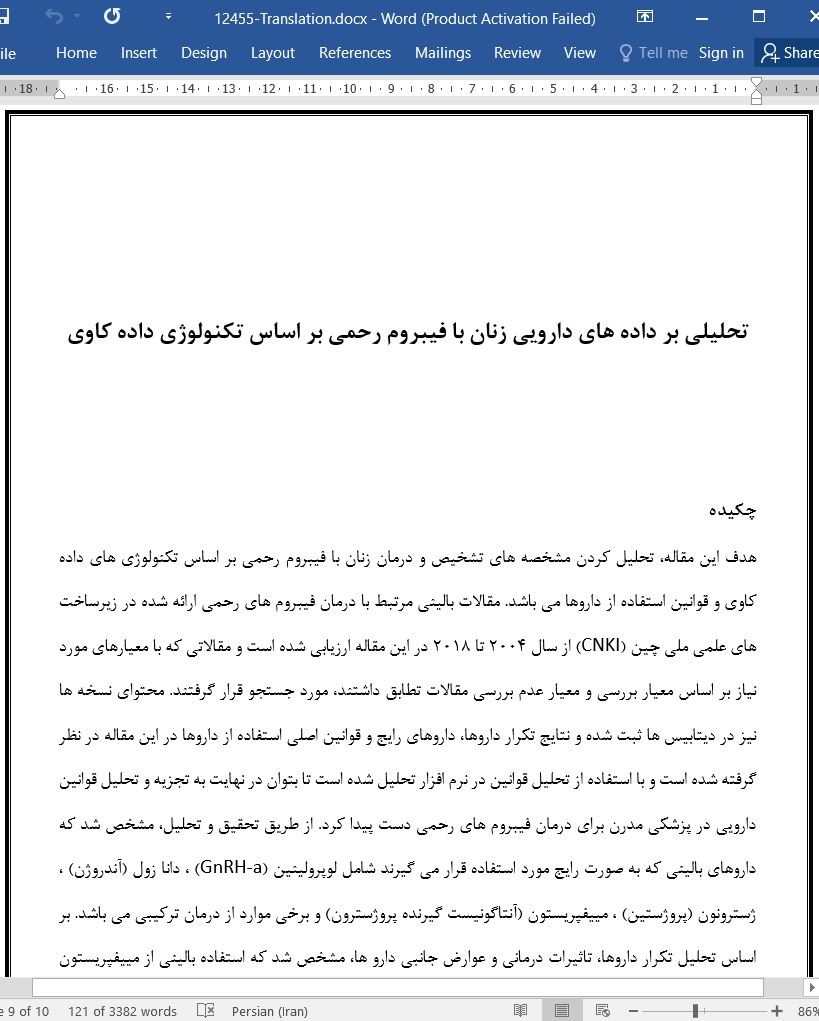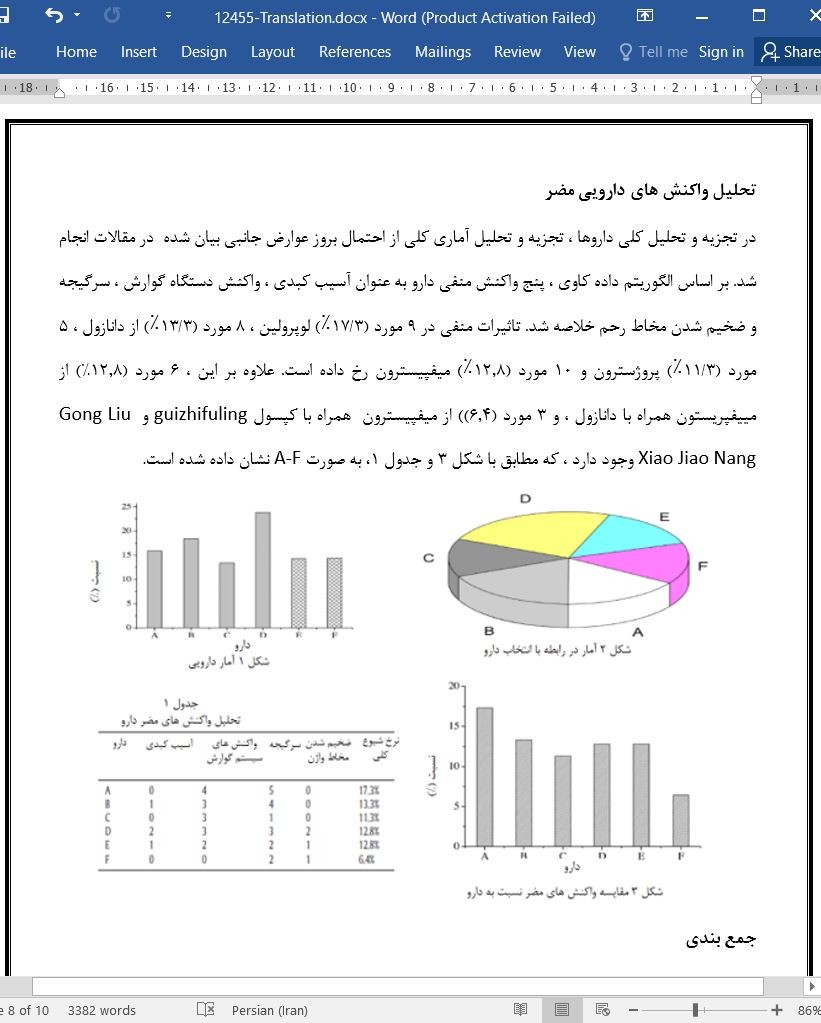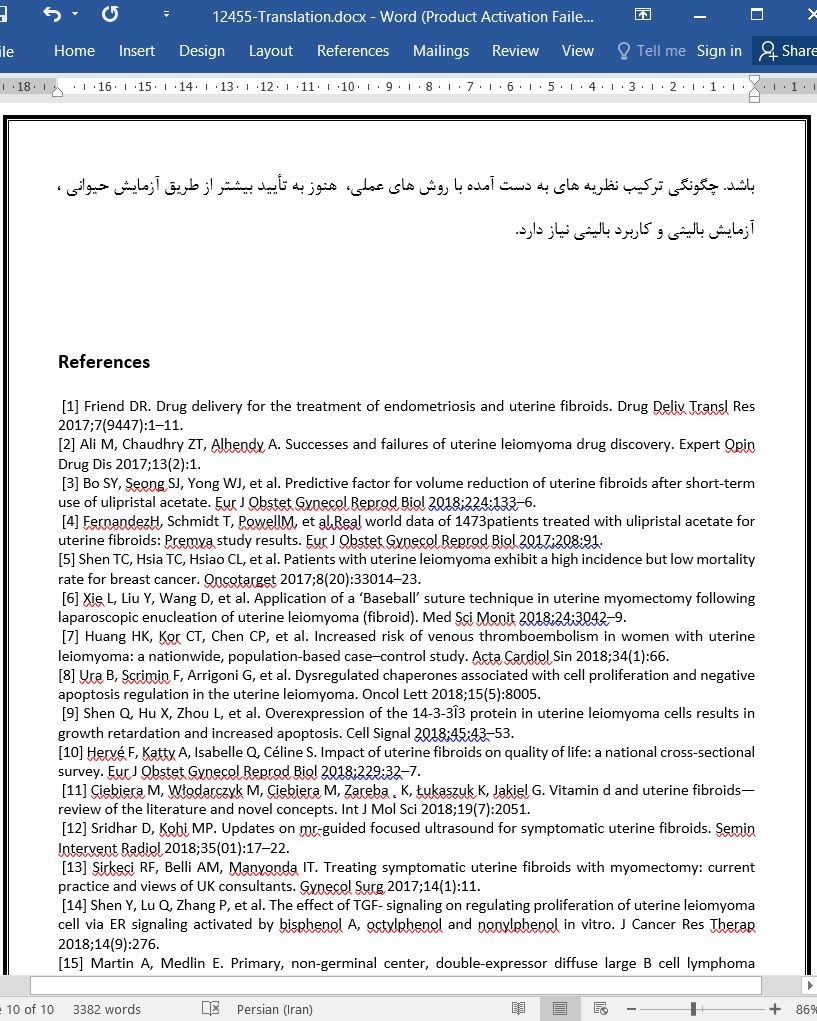
دانلود مقاله تحلیلی بر داده های دارویی زنان با فیبروم رحمی بر اساس تکنولوژی داده کاوی
چکیده
هدف این مقاله، تحلیل کردن مشخصه های تشخیص و درمان زنان با فیبروم رحمی بر اساس تکنولوژی های داده کاوی و قوانین استفاده از داروها می باشد. مقالات بالینی مرتبط با درمان فیبروم های رحمی ارائه شده در زیرساخت های علمی ملی چین (CNKI) از سال 2004 تا 2018 در این مقاله ارزیابی شده است و مقالاتی که با معیارهای مورد نیاز بر اساس معیار بررسی و معیار عدم بررسی مقالات تطابق داشتند، مورد جستجو قرار گرفتند. محتوای نسخه ها نیز در دیتابیس ها ثبت شده و نتایج تکرار داروها، داروهای رایج و قوانین اصلی استفاده از داروها در این مقاله در نظر گرفته شده است و با استفاده از تحلیل قوانین در نرم افزار تحلیل شده است تا بتوان در نهایت به تجزیه و تحلیل قوانین دارویی در پزشکی مدرن برای درمان فیبروم های رحمی دست پیدا کرد. از طریق تحقیق و تحلیل، مشخص شد که داروهای بالینی که به صورت رایج مورد استفاده قرار می گیرند شامل لوپرولینین (GnRH-a) ، دانا زول (آندروژن) ، ژسترونون (پروژستین) ، مییفپریستون (آنتاگونیست گیرنده پروژسترون) و برخی موارد از درمان ترکیبی می باشد. بر اساس تحلیل تکرار داروها، تاثیرات درمانی و عوارض جانبی دارو ها، مشخص شد که استفاده بالینی از مییفپریستون در درمان های فیبروم های رحمی معمولا رایج می باشد که این دارو باعث شکل گیری تاثیر محسوس همراه با عوارض جانبی خفیف می شود به همین دلیل بهتر است که این دارو در شرایط بالینی بیشتر مورد استفاده قرار گیرد. ازین رو، نتایج این مطالعه میتواند مبانی جدیدی ار برای تحقیقات بالینی و مبنایی برای پزشکی سنتی چینی در درمان فیبروم های رحمی ایجاد کند اما هنوز هم نیازمند اعتبار سنجی توسط تفسیر متخصص ها، تحقیقات آزمایشی و روش های دیگر می باشد.
مقدمه
فیبروم های رحمی یکی از رایج ترین تومورهای خوش خیم در زنان هستند که در اثر تکثیر تک کلونی از سلول های عضلانی صاف رحم ایجاد می شوند. این فیبروم های رحمی بیشتر در زنان در سن حاملگی ایجاد می شوند و تا حد زیادی تحت تاثیر استروژن و پروژسترون می باشند. رخداد این فیبروم های رحمی مرتبط با نژاد می باشد و یکی از بیشترین شیوع های این بیماری در میان زنان آفریقایی آمریکایی می باشد که 80% از جمعیت این بیماران را ایجاد می کنند [1]. به علاوه، عوامل پرخطر برای فیبروم های رحمی نیز شامل سن، نخستین قاعدگی در سن پایین، حاملگی در سن بالا، قهوه، استفاده زیاد از الکل، جهش های ژنی، چاقی و مشکلات دیگر می باشد [2]. انواع مختلف از نمونه علائم برای فیبروم های رحمی وجود دارد که شامل خونریزی رحمی، طولانی شدن دوره قاعدگی، درد، کم خونی، سقط جنین، ناباروری، حالت نامناسب در نوار ، و مشکلات مقعدی و مثانه می باشند. فیبروم های رحمی نه تنها بر روی باروری بیمار تاثیر دارند، بلکه بر روی کیفیت زندگی و وضعیت روانی بیمار نیز موثر هستند. از نظر ناباروری، این مشکل می تواند تا کمتر از 3% از علت های ناباروری را ایجاد کند [3و4].
جمع بندی
فیبروم های رحمی در بدن زنان نوعی از توموهای خوش خیم است که به صورت رایج در اندام تولید مثل زنان دیده می شود و به دلیل رشد بیش از حد عضلات صاف رحمی و بافت های همبند ایجاد می شود که با نام لیومیوم رحمی نیز شناخته می شود. این بیماری یکی زا رایج ترین تومورهای خوش خیم در بدن زنان می باشد. بیشتر بیماران هیچ نشانه بالینی خاصی در اوایل این بیماری از خودشان نشان نمی دهند. بقیه بیماران نیز بیشتر نشانه هایی مانند تغییرات در دوره های قاعدگی، مانند طولانی شدن مدت زمان قاعدگی، افزایش حجم خونریزی، حالت های غیر عادی ترشح های واژن و اکثر آن ها با حالت های کم خونی، شناسایی می شوند.
Abstract
The purpose of this study was to analyze the characteristics of the diagnosis and treatment of female uterine fibroids based on data mining technology and the medication rule. Clinical literature related to the treatment of uterine fibroids by Chinese National Knowledge Infrastructure (CNKI) from 2004 to 2018 were searched, and the literature meeting the requirements were selected according to the inclusion criteria and exclusion criteria. The contents of the prescription were recorded into the database, and the results of drug frequency, common drugs and core rules, etc. were obtained by the rule analysis of the software, so as to analyze the medication rules of modern doctors in treating uterine fibroids. Through research and analysis, it showed that common clinical drugs include leuprorelin (GnRH-a), danazol (androgen), gestrinone (progestin), mifepristone (progesterone receptor antagonist), and some cases of combination therapy. Based on the analysis of the frequency of drug, treatment effect and adverse drug reactions, it was found that the clinical application of mifepristone in the treatment of uterine fibroids was relatively common, with significant drug effect and mild adverse reactions, which was worthy of clinical promotion and application. Therefore, the results of this study provide a new basis for the clinical and basic research of traditional Chinese medicine in the treatment of uterine fibroids, but it still needs the verification of expert interpretation, experimental research and other methods.
Introduction
Uterine fibroids are one of the most common benign tumors in women and are derived from the monoclonal proliferation of uterine smooth muscle cells. Uterine fibroids are more common in women of childbearing age and are greatly affected by estrogen and progesterone. The incidence of uterine fibroids is related to race, with the highest incidence among African Americans, accounting for 80% [1]. In addition, the high-risk factors of fibroids also include age, early menarche, late childbirth, coffee, alcohol abuse, gene mutation, obesity and other problems [2]. There are a variety of clinical manifestations of uterine fibroids, including menorrhagia, prolonged menstruation, pain, anemia, abortion, infertility, abnormal band, bladder and rectal compression symptoms. Uterine fibroids will not only affect the fertility of patients, but also affect the quality of life and psychological status of patients. In terms of infertility, infertility caused by uterine fibroids alone accounts for less than 3% of all infertile patients [3,4].
Conclusion
Uterine fibroid is a kind of benign tumor commonly observed in female reproductive organs, which is caused by hyperplasia of uterine smooth muscle and connective tissue, also known as uterine leiomyoma. It is one of the more common benign tumors in the human body. Most patients have no obvious clinical symptoms in the early stage of the disease. The rest of the patients are mainly manifested as menstrual changes, such as prolonged menstruation, menstrual volume,leucorrhea abnormalities, andmostpatients can appear anemia symptoms.
چکیده
مقدمه
محتوای تحقیقاتی
منابع مقالات
ایجاد دیتابیس
نرم افزارهای آماری و روش های داده کاوی
نتایج تحقیقات
آمار دارویی
تحلیل تاثیر داروها
تحلیل واکنش های دارویی مضر
جمع بندی
منابع
ABSTRACT
Introduction
Research contents
Source of literature
Establishment of the database
Statistical software and data mining methods
Research results
Drug statistics
Analysis of drug effects
Analysis of adverse drug reactions
Conclusion
References
- اصل مقاله انگلیسی با فرمت ورد (word) با قابلیت ویرایش
- ترجمه فارسی مقاله با فرمت ورد (word) با قابلیت ویرایش، بدون آرم سایت ای ترجمه
- ترجمه فارسی مقاله با فرمت pdf، بدون آرم سایت ای ترجمه



